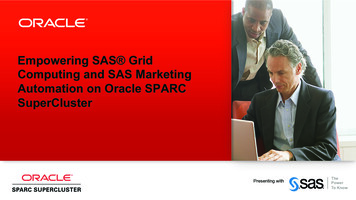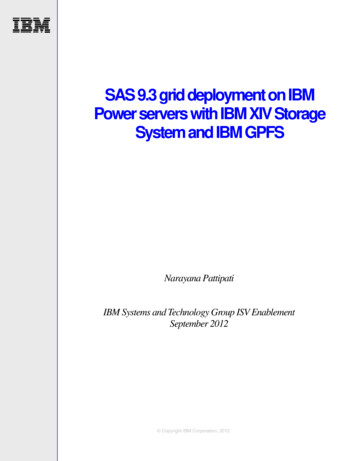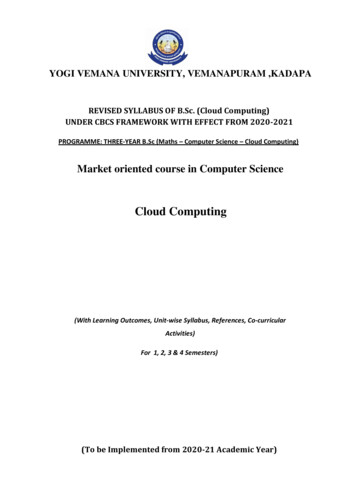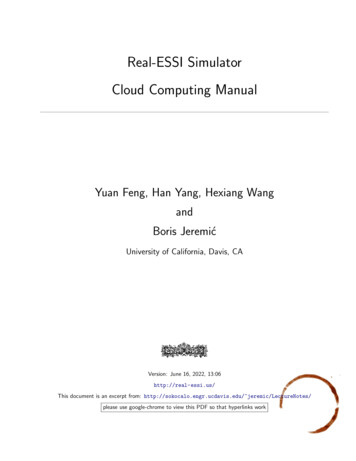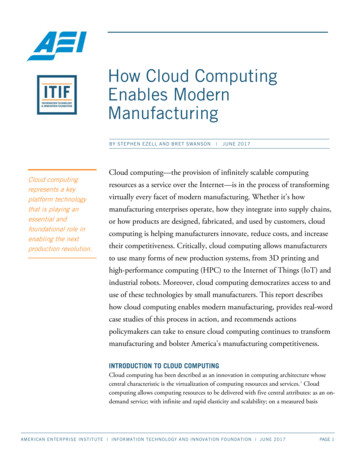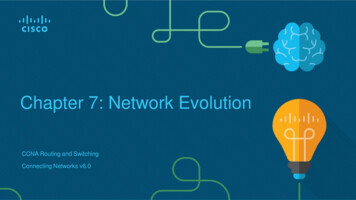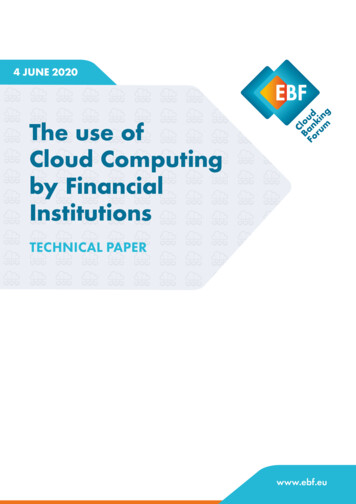
Transcription
Grid & Cloud ComputingUnit I NotesGRID AND CLOUD COMPUTINGUNIT IINTRODUCTIONEvolution of Distributed computing: Scalable computing over the Internet – Technologies fornetwork based systems – clusters of cooperative computers - Grid computing Infrastructures –cloud computing - service oriented architecture – Introduction to Grid Architecture and standards– Elements of Grid – Overview of Grid Architecture.1. EVOLUTION OF DISTRIBUTED COMPUTINGGrids enable access to shared computing power and storage capacity from your desktop.Clouds enable access to leased computing power and storage capacity from your desktop. Grids are an open source technology. Resource users and providers alike can understandand contribute to the management of their grid Clouds are a proprietary technology. Only the resource provider knows exactly howtheir cloud manages data, job queues, security requirements and so on. The concept of grids was proposed in 1995. The Open science grid (OSG) started in 1995The EDG (European Data Grid) project began in 2001. In the late 1990 s Oracle and EMC offered early private cloud solutions. However theterm cloud computing didn't gain prominence until 2007.SCALABLE COMPUTING OVER THE INTERNETInstead of using a centralized computer to solve computational problems, a parallel anddistributed computing system uses multiple computers to solve large-scale problems over theInternet. Thus, distributed computing becomes data-intensive and network-centric.The Age of Internet Computingo high-performance computing (HPC) applications is no longer optimal for measuringsystem performanceo The emergence of computing clouds instead demands high-throughput computing (HTC)systems built with parallel and distributed computing technologieso We have to upgrade data centers using fast servers, storage systems, and high-bandwidthnetworks.The Platform Evolutiono From 1950 to 1970, a handful of mainframes, including the IBM 360 and CDC 6400Department of CSE1
Grid & Cloud ComputingUnit I Noteso From 1960 to 1980, lower-cost minicomputers such as the DEC PDP 11 and VAXSerieso From 1970 to 1990, we saw widespread use of personal computers built with VLSImicroprocessors.o From 1980 to 2000, massive numbers of portable computers and pervasive devicesappeared in both wired and wireless applicationso Since 1990, the use of both HPC and HTC systems hidden in clusters, grids, orInternet clouds has proliferatedFigure 1.1 Scalable Computing Over the InternetOn the HPC side, supercomputers (massively parallel processors or MPPs) aregradually replaced by clusters of cooperative computers out of a desire to sharecomputing resources. The cluster is often a collection of homogeneous computenodes that are physically connected in close range to one another.On the HTC side, peer-to-peer (P2P) networks are formed for distributed file sharingand content delivery applications. A P2P system is built over many client machines (aconcept we will discuss further in Chapter 5). Peer machines are globally distributedin nature. P2P, cloud computing, and web service platforms are more focused onHTC applications than on HPC applications. Clustering and P2P technologies lead tothe development of computational grids or data grids.Department of CSE2
Grid & Cloud ComputingUnit I NotesFor many years, HPC systems emphasize the raw speed performance. The speed ofHPC systems has increased from Gflops in the early 1990s to now Pflops in 2010.The development of market-oriented high-end computing systems is undergoing astrategic change from an HPC paradigm to an HTC paradigm. This HTC paradigmpays more attention to high-flux computing. The main application for high-fluxcomputing is in Internet searches and web services by millions or more userssimultaneously. The performance goal thus shifts to measure high throughput or thenumber of tasks completed per unit of time. HTC technology needs to not onlyimprove in terms of batch processing speed, but also address the acute problems ofcost, energy savings, security, and reliability at many data and enterprise computingcenters.Advances in virtualization make it possible to see the growth of Internet clouds as anew computing paradigm. The maturity of radio-frequency identification (RFID),Global Positioning System (GPS), and sensor technologies has triggered thedevelopment of the Internet of Things (IoT). These new paradigms are only brieflyintroduced here.The high-technology community has argued for many years about the precisedefinitions of centralized computing, parallel computing, distributed computing, andcloud computing. In general, distributed computing is the opposite of centralizedcomputing. The field of parallel computing overlaps with distributed computing to agreat extent, and cloud computing overlaps with distributed, centralized, and parallelcomputing.TermsCentralized computingThis is a computing paradigm by which all computer resources are centralized inone physical system. All resources (processors, memory, and storage) are fully shared andtightly coupled within one integrated OS. Many data centers and supercomputers arecentralized systems, but they are used in parallel, distributed, and cloud computingapplications. Parallel computingIn parallel computing, all processors are either tightly coupled with centralizedshared memory or loosely coupled with distributed memory. Inter processorDepartment of CSE3
Grid & Cloud ComputingUnit I Notescommunication is accomplished through shared memory or via message passing.Acomputer system capable of parallel computing is commonly known as a parallelcomputer. Programs running in a parallel computer are called parallel programs. Theprocess of writing parallel programs is often referred to as parallel programming. Distributed computing This is a field of computer science/engineering that studiesdistributed systems. A distributed system consists of multiple autonomous computers,each having its own private memory, communicating through a computer network.Information exchange in a distributed system is accomplished through message passing.A computer program that runs in a distributed system is known as a distributed program.The process of writing distributed programs is referred to as distributed programming. Cloud computing An Internet cloud of resources can be either a centralized or adistributed computing system. The cloud applies parallel or distributed computing, orboth. Clouds can be built with physical or virtualized resources over large data centersthat are centralized or distributed. Some authors consider cloud computing to be a formof utility computing or service computing . As an alternative to the preceding terms,some in the high-tech community prefer the term concurrent computing or concurrentprogramming. These terms typically refer to the union of parallel computing anddistributing computing, although biased practitioners may interpret them differently. Ubiquitous computing refers to computing with pervasive devices at any place and timeusing wired or wireless communication. The Internet of Things (IoT) is a networkedconnection of everyday objects including computers, sensors, humans, etc. The IoT issupported by Internet clouds to achieve ubiquitous computing with any object at anyplace and time. Finally, the term Internet computing is even broader and covers allcomputing paradigms over the Internet. This book covers all the aforementionedcomputing paradigms, placing more emphasis on distributed and cloud computing andtheir working systems, including the clusters, grids, P2P, and cloud systems.Internet of Things The traditional Internet connects machines to machines or web pages to web pages. Theconcept of the IoT was introduced in 1999 at MIT .Department of CSE4
Grid & Cloud Computing Unit I NotesThe IoT refers to the networked interconnection of everyday objects, tools, devices, orcomputers. One can view the IoT as a wireless network of sensors that interconnect allthings in our daily life. It allows objects to be sensed and controlled remotely across existing networkinfrastructure.TECHNOLOGIES FOR NETWORK-BASED SYSTEMSMulticore CPUs and Multithreading TechnologiesGPU Computing to Exascale and Beyond.Memory, Storage, and Wide-Area NetworkingVirtual Machines and Virtualization MiddlewareData Center Virtualization for Cloud Computing.Multicore CPUs and Multithreading TechnologiesProcessor speed is measured in millions of instructions per second (MIPS) andnetwork bandwidth is measured in megabits per second (Mbps) or gigabits per second(Gbps). The unit GE refers to 1 Gbps Ethernet bandwidth.Advances in CPU Processors advanced CPUs or microprocessor chips assume amulticore architecture with dual, quad, six, or more processing cores. Theseprocessors exploit parallelism at ILP and TLP levels.ILP mechanisms include multiple-issue superscalar architecture, dynamic branchprediction, and speculative execution, among others. These ILP techniques demandhardware and compiler support.Figure 1.2 Modern Multicore CPU chip using a hierarchy of cachesDepartment of CSE5
Grid & Cloud ComputingUnit I NotesIn addition, DLP and TLP are highly explored in graphics processing units (GPUs)that adopt a many-core architecture with hundreds to thousands of simple cores.Both multi-core CPU and many-core GPU processors can handle multiple instructionthreads at different magnitudes today.Figure 1.2 shows the architecture of a typical multicore processor. Each core isessentially a processor with its own private cache (L1 cache). Multiple cores arehoused in the same chip with an L2 cache that is shared by all cores. In the future,multiple CMPs could be built on the same CPU chip with even the L3 cache on thechip. Multicore and multithreaded CPUs are equipped with many high-endprocessors, including the Intel i7, Xeon, AMD Opteron, Sun Niagara, IBM Power 6,and X cell processors. Each core could be also multithreaded.Multicore CPU and Many-Core GPU ArchitecturesMulticore CPUs may increase from the tens of cores to hundreds or more in the future.But the CPU has reached its limit in terms of exploiting massive DLP due to theaforementioned memory wall problem. This has triggered the development of many-coreGPUs with hundreds or more thin cores. Both IA-32 and IA-64 instruction setarchitectures are built into commercial CPUs. Now, x-86 processors have been extendedto serve HPC and HTC systems in some high-end server processors.Many RISC processors have been replaced with multicore x-86 processors and manycore GPUs in the Top 500 systems. This trend indicates that x-86 upgrades will dominatein data centers and supercomputers. The GPU also has been applied in large clusters tobuild supercomputers in MPPs. In the future, the processor industry is also keen todevelop asymmetric or heterogeneous chip multiprocessors that can house both fat CPUcores and thin GPU cores on the same chip.Figure 1.3 CPU / GPU Architecture ComparisonDepartment of CSE6
Grid & Cloud ComputingUnit I NotesMulticore CPUs and Multithreading TechnologiesConsider in Figure 1.4 the dispatch of five independent threads of instructions to fourpipelined data paths (functional units) in each of the following five processor categories,from left to right: a four-issue superscalar processor, a fine-grain multithreadedprocessor, a coarse-grain multithreaded processor, a two-core CMP, and a simultaneousmultithreaded (SMT) processor. The superscalar processor is single-threaded with fourfunctional units. Each of the three multithreaded processors is four-way multithreadedover four functional data paths. In the dual-core processor, assume two processing cores,each a single-threaded two-way superscalar processor.Figure 1.4 Five Micro-Architectures in Modern CPU ProcessorsInstructions from different threads are distinguished by specific shading patterns forinstructions from five independent threads. Typical instruction scheduling patterns areshown here. Only instructions from the same thread are executed in a superscalarprocessor. Fine-grain multithreading switches the execution of instructions from differentthreads per cycle. Course-grain multithreading executes many instructions from the samethread for quite a few cycles before switching to another thread. The multicore CMPexecutes instructions from different threads completely. The SMT allows simultaneousscheduling of instructions from different threads in the same cycle.Department of CSE7
Grid & Cloud ComputingUnit I NotesThese execution patterns closely mimic an ordinary program. The blank squarescorrespond to no available instructions for an instruction data path at a particularprocessor cycle. More blank cells imply lower scheduling efficiency. The maximum ILPor maximum TLP is difficult to achieve at each processor cycle.GPU Computing to Exascale and BeyondA GPU is a graphics coprocessor or accelerator mounted on a computer’s graphics cardor video card. A GPU offloads the CPU from tedious graphics tasks in video editingapplications. The world’s first GPU, the GeForce 256, was marketed by NVIDIA in1999. These GPU chips can process a minimum of 10 million polygons per second, andare used in nearly every computer on the market today. Some GPU features were alsointegrated into certain CPUs. Traditional CPUs are structured with only a few cores. Forexample, the Xeon X5670 CPU has six cores. However, a modern GPU chip can be builtwith hundreds of processing cores.Unlike CPUs, GPUs have a throughput architecture that exploits massive parallelism byexecuting many concurrent threads slowly, instead of executing a single long thread in aconventional microprocessor very quickly. Lately, parallel GPUs or GPU clusters havebeen garnering a lot of attention against the use of CPUs with limited parallelism.General-purpose computing on GPUs, known as GPGPUs, have appeared in the HPCfield. NVIDIA’s CUDA model was for HPC using GPGPUs.How GPUs WorkEarly GPUs functioned as coprocessors attached to the CPU. Today, the NVIDIA GPUhas been upgraded to 128 cores on a single chip. Furthermore, each core on a GPU canhandle eight threads of instructions. This translates to having up to 1,024 threadsexecuted concurrently on a single GPU. This is true massive parallelism, compared toonly a few threads that can be handled by a conventional CPU. The CPU is optimized forlatency caches, while the GPU is optimized to deliver much higher throughput withexplicit management of on-chip memory.Modern GPUs are not restricted to accelerated graphics or video coding. They are used inHPC systems to power supercomputers with massive parallelism at multicore andmultithreading levels. GPUs are designed to handle large numbers of floating-pointDepartment of CSE8
Grid & Cloud ComputingUnit I Notesoperations in parallel. In a way, the GPU offloads the CPU from all data-intensivecalculations, not just those that are related to video processing.Conventional GPUs are widely used in mobile phones, game consoles, embeddedsystems, PCs, and servers. The NVIDIA CUDA Tesla or Fermi is used in GPU clustersor in HPC systems for parallel processing of massive floating-pointing data.GPU Programming Model Figure 1.7 shows the interaction between a CPU and GPU in performing parallelexecution of floating-point operations concurrently. The CPU is the conventionalmulticore processor with limited parallelism to exploit. The GPU has a many-corearchitecture that has hundreds of simple processing cores organized as multiprocessors.Each core can have one or more threads. Essentially, the CPU’s floating-point kernelcomputation role is largely offloaded to the many-core GPU. The CPU instructs the GPUto perform massive data processing. The bandwidth must be matched between the onboard main memory and the on-chip GPU memory.This process is carried out in NVIDIA’s CUDA programming using the GeForce 8800 orTesla and Fermi GPUs.Figure 1.5 The use of a GPU along with a CPU for massively parallel ExecutionIn the future, thousand-core GPUs may appear in Exascale (Eflops or 1018 flops)systems. This reflects a trend toward building future MPPs with hybrid architectures of bothtypes of processing chips. In a DARPA report published in September 2008, four challenges areidentified for exascale computing: (1) energy and power, (2) memory and storage, (3)concurrency and locality, and (4) system resiliency.Department of CSE9
Grid & Cloud ComputingUnit I NotesPower Efficiency of the GPUBy extrapolating current technology and computer architecture, it was estimated that 60Gflops/watt per core is needed to run an exaflops system (see Figure 1.10). Power constrainswhat we can put in a CPU or GPU chip. Dally has estimated that the CPU chip consumes about 2nJ/instruction, while the GPU chip requires 200 pJ/instruction, which is 1/10 less than that of theCPU. The CPU is optimized for latency in caches and memory, while the GPU is optimized forthroughput with explicit management of on-chip memory. Figure 1.9 compares the CPU andGPU in their performance/power ratio measured in Gflops/ watt per core.Memory, Storage, and Wide-Area NetworkingMemory TechnologyThe capacity increase of disk arrays will be even greater in the years to come. Fasterprocessor speed and larger memory capacity result in a wider gap between processors andmemory. The memory wall may become even worse a problem limiting the CPU performance inthe future.Disks and Storage TechnologyEventually, power consumption, cooling, and packaging will limit large systemdevelopment. Power increases linearly with respect to clock frequency and quadratic ally withrespect to voltage applied on chips. Clock rate cannot be increased indefinitely. Lowered voltagesupplies are very much in demand. Jim Gray once said in an invited talk at the University ofSouthern California, ―Tape units are dead, disks are tape units, flashes are disks, and memoryare caches now.System-Area InterconnectsThe nodes in small clusters are mostly interconnected by an Ethernet switch or a localarea network (LAN). As Figure 1.6 shows, a LAN typically is used to connect client hosts to bigservers. A storage area network (SAN) connects servers to network storage such as disk arrays.Network attached storage (NAS) connects client hosts directly to the disk arrays. All three typesof networks often appear in a large cluster built with commercial network components. If nolarge distributed storage is shared, a small cluster could be built with a multiport GigabitEthernet switch plus copper cables to link the end machines. All three types of networks arecommercially available.Department of CSE10
Grid & Cloud ComputingUnit I NotesFigure 1.6 Three interconnection networks for connecting servers, Client Hosts andStorage DevicesAn increase factor of two per year on network performance was reported, which is fasterthan Moore’s law on CPU speed doubling every 18 months. The implication is that morecomputers will be used concurrently in the future. High-bandwidth networking increases thecapability of building massively distributed systems.Wide-Area NetworkingAn increase factor of two per year on network performance was reported, which isfaster than Moore’s law on CPU speed doubling every 18 months. The implication is thatmore computers will be used concurrently in the future. High-bandwidth networking increasesthe capability of building massively distributed systems.Virtual Machines and Virtualization MiddlewareA conventional computer has a single OS image. This offers a rigid architecture thattightly couples application software to a specific hardware platform. Some software running wellon one machine may not be executable on another platform with a different instruction set undera fixed OS. Virtual machines (VMs) offer novel solutions to underutilized resources, applicationinflexibility, software manageability, and security concerns in existing physical machines.Department of CSE11
Grid & Cloud ComputingUnit I NotesFigure 1.7 Three VM Architectures(b,c,d) compared with Physical Machine(a)Today, to build large clusters, grids, and clouds, we need to access large amounts ofcomputing, storage, and networking resources in a virtualized manner. We need to aggregatethose resources, and hopefully, offer a single system image. In particular, a cloud of provisionedresources must rely on virtualization of processors, memory, and I/O facilities dynamically.Virtual MachinesIn Figure 1.7, the host machine is equipped with the physical hardware, as shown at thebottom of the figure. An example is an x-86 architecture desktop running its installed WindowsOS, as shown in part (a) of the figure. The VM can be provisioned for any hardware system. TheVM is built with virtual resources managed by a guest OS to run a specific application. Betweenthe VMs and the host platform, one needs to deploy a middleware layer called a virtual machinemonitor (VMM). Figure 1.7(b) shows a native VM installed with the use of a VMM called ahypervisor in privileged mode. For example, the hardware has x-86 architecture running theWindows system.The guest OS could be a Linux system and the hypervisor is the XEN system developedat Cambridge University. This hypervisor approach is also called bare-metal VM, because thehypervisor handles the bare hardware (CPU, memory, and I/O) directly. Architecture is the hostVM shown in Figure 1.7(c). Here the VMM runs in nonprivileged mode. The host OS need notbe modified.The VM can also be implemented with a dual mode, as shown in Figure 1.7(d). Part ofthem VMM runs at the user level and another part runs at the supervisor level. In this case, thehost OS may have to be modified to some extent. Multiple VMs can be ported to a givenDepartment of CSE12
Grid & Cloud ComputingUnit I Noteshardware system to support the virtualization process. The VM approach offers hardwareindependence of the OS and applications. The user application running on its dedicated OS couldbe bundled together as a virtual appliance that can be ported to any hardware platform. The VMcould run on an OS different from that of the host computer.VM Primitive OperationsThe VMM provides the VM abstraction to the guest OS. With full virtualization, theVMM exports a VM abstraction identical to the physical machine so that a standard OSsuch as Windows 2000 or Linux can run just as it would on the physical hardware. First, the VMs can be multiplexed between hardware machines, as shown in Figure1.8(a). Second, a VM can be suspended and stored in stable storage, as shown in Figure 1.8(b). Third, a suspended VM can be resumed or provisioned to a new hardware platform, asshown in Figure 1.8(c).Figure 1.8 VM Multiplexing, Suspension, Provision and Migration indistributed computing environment Finally, a VM can be migrated from one hardware platform to another, as shown in Figure1.8(d). These VM operations enable a VM to be provisioned to any available hardware platform.They also enable flexibility in porting distributed application executions. Furthermore, the VMapproach will significantly enhance the utilization of server resources. Multiple server functionscan be consolidated on the same hardware platform to achieve higher system efficiency. ThisDepartment of CSE13
Grid & Cloud ComputingUnit I Noteswill eliminate server sprawl via deployment of systems as VMs, which move transparency to theshared hardware. With this approach, VMware claimed that server utilization could be increasedfrom its current 5–15 percent to 60–80 percent.Data Center Virtualization for Cloud Computing Cloud architecture is built with commodity hardware and network devices. Almost allcloud platforms choose the popular x86 processors. Low-cost terabyte disks and Gigabit Ethernet are used to build data centers. Data center design the performance/price ratio over speed performance alone. In other words, storage and energy efficiency are more important than speedperformance.a) Data Center Growth and Cost BreakdownA large data center may be built with thousands of servers. Smaller data centers aretypically built with hundreds of servers. The cost to build and maintain data center servers hasincreased over the years.b) Low-Cost Design PhilosophyHigh-end switches or routers may be too cost-prohibitive for building data centers.Thus, using high-bandwidth networks may not fit the economics of cloud computing.c) Convergence of TechnologiesEssentially, cloud computing is enabled by the convergence of technologies in four areas:(1) hardware virtualization and multi-core chips, (2) utility and grid computing, (3) SOA, Web2.0, and WS mashups, and (4) atonomic computing and data center automation. Hardwarevirtualization and multicore chips enable the existence of dynamic configurations in the cloud.Utility and grid computing technologies lay the necessary foundation for computing clouds.Recent advances in SOA, Web 2.0, and mashups of platforms are pushing the cloud another stepforward. Finally, achievements in autonomic computing and automated data center operationscontribute to the rise of cloud computing.Iterative MapReduce extends MapReduce to support a broader range of data miningalgorithms commonly used in scientific applications. The cloud runs on an extremely largecluster of commodity computers. Internal to each cluster node, multithreading is practiced with alarge number of cores in many-core GPU clusters. Data-intensive science, cloud computing, andmulticore computing are converging and revolutionizing the next generation of computing inDepartment of CSE14
Grid & Cloud ComputingUnit I Notesarchitectural design and programming challenges. They enable the pipeline: Data becomesinformation and knowledge, and in turn becomes machine wisdom as desired in SOASYSTEM MODELS FOR DISTRIBUTED AND CLOUD COMPUTING Distributed and cloud computing systems are built over a large number of autonomouscomputer nodes. These node machines are interconnected by SANs, LANs, or WANs in ahierarchical manner. With today’s networking technology, a few LAN switches caneasily connect hundreds of machines as a working cluster. A WAN can connect many local clusters to form a very large cluster of clusters.Clusters of Cooperative ComputersA computing cluster consists of interconnected stand-alone computers which workcooperatively as a single integrated computing resource. In the past, clustered computer systems have demonstrated impressive results in handlingheavy workloads with large data sets. 1.3.1.1 Cluster Architecturecluster built around a low-latency, high bandwidth interconnection network. This networkcan be as simple as a SAN or a LAN (e.g., Ethernet).Figure 1.9 A Cluster of Servers interconnected by a high speed LAN or SAN withshared I/O devices and Disk ArraysDepartment of CSE15
Grid & Cloud ComputingUnit I NotesFigure 1.9 shows the architecture of a typical server cluster built around a low-latency,high bandwidth interconnection network. This network can be as simple as a SAN (e.g.,Myrinet) or a LAN (e.g., Ethernet). To build a larger cluster with more nodes, the interconnection network can be built withmultiple levels of Gigabit Ethernet, or InfiniBand switches. Through hierarchical construction using a SAN, LAN, or WAN, one can build scalableclusters with an increasing number of nodes. The cluster is connected to the Internet via avirtual private network (VPN) gateway. The gateway IP address locates the cluster. The system image of a computer is decidedby the way the OS manages the shared cluster resources.Most clusters have loosely coupled node computers. All resources of a server node aremanaged by their own OS. Thus, most clusters have multiple system images as a result of havingmany autonomous nodes under different OS control.Single-System Image(SSI) Ideal cluster should merge multiple system images into a single-system image (SSI). Cluster designers desire a cluster operating system or some middleware to support SSI atvarious levels, including the sharing of CPUs, memory, and I/O across all cluster nodes.An SSI is an illusion created by software or hardware that presents a collection of resources asone integrated, powerful resource. SSI makes the cluster appear like a single machine to the user.A cluster with multiple system images is nothing but a collection of independent computers.Hardware, Software, and Middleware Support Clusters exploring massive parallelism are commonly known as MPPs. Almost all HPCclusters in the Top 500 list are also MPPs. The building blocks are computer nodes (PCs, workstations, servers, or SMP), specialcommunication software such as PVM, and a network interface card in each computernode.Most clusters run under the Linux OS. The computer nodes are interconnected by a high-bandwidth network (such as Gigabit Ethernet, Myrinet, InfiniBand, etc.). Special clustermiddleware supports are needed to create SSI or high availability (HA). Both sequential andparallel applications can run on the cluster, and special parallel environments are needed tofacilitate use of the cluster resources. For example, distributed memory has multiple images.Users may want all distributed memory to be shared by all servers by forming distributed sharedDepartment of CSE16
Grid & Cloud ComputingUnit I Notesmemory (DSM). Many SSI features are expensive or difficult to achieve at various clusteroperational levels. Instead of achieving SSI, many clusters are loosely coupled machines. Usingvirtualization, one can build many virtual clusters dynamically, upon user demand.Major Cluster Design Issues Unfortunately, a cluster-wide OS for complete resource sharing is not available yet.Middleware or OS extensions were developed at the user space to achieve SSI at selectedfunctional levels. Without this middleware, cluster nodes cannot work together effectively to achievecooperative computing. The software environments and applications must rely on themiddleware to achieve high performance. The cluster benefits come from scalabl
Grid & Cloud Computing Unit I Notes Department of CSE 1 GRID AND CLOUD COMPUTING UNIT I INTRODUCTION Evolution of Distributed computing: Scalable computing over the Internet - Technologies for network based systems - clusters of cooperative computers - Grid computing Infrastructures - cloud computing - service oriented architecture .



